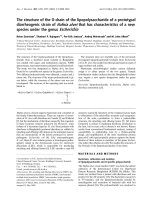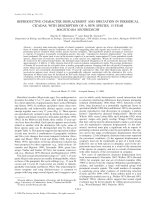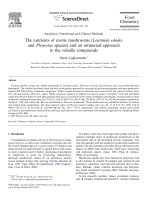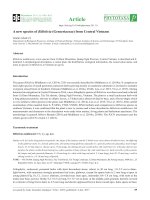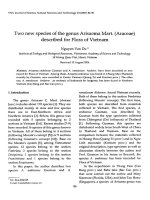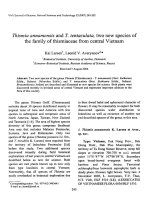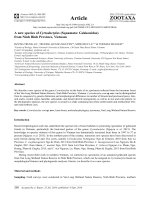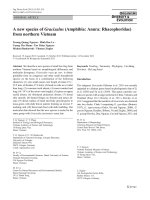ILLUSTRATIONS OF NEW SPECIES OF EXOTIC BUTTERFLIES V1, HEWITSON
Bạn đang xem bản rút gọn của tài liệu. Xem và tải ngay bản đầy đủ của tài liệu tại đây (9.46 MB, 244 trang )
ILLUSTRATIONS
OF
NEW
SPECIES
OF
EXOTIC BUTTERFLIES,
SELECTED
chiefly from the
COLLECTIONS
OF
W. WILSON SAUNDERS and WILLIAM
WILLIAM
C.
C.
HEWITSON.
HEWITSON.
///
VOL.
1.
c\qbA3
JOHN VAN VOORST, LONDON.
LUNDON
:
WUUDFALL AND KINDER. PRINTERS, ANGEL COURT, SKINNER STREET.
INTRODUCTION.
Although
close,
tlie
first
volume of the " Exotic Butterflies," which
has not succeeded
with a second
—having
consider any loss which
ment of our
own
we do
abundant materials with which
we may
to
is
now brought
to a
not hesitate to proceed
fill
its
pages
—
willing to
sustain as a slight contribution towards the advance-
and unwilling that the many beautiful things which
eyes should not also be enjoyed by our brother naturalists.
Two hundred and
and
pecuniary point of view,
favourite science,
have delighted our
species,
in a
seventeen butterflies have been figured as
I believe they will
new and
stand the test of close examination.
No
distinct
one can
deprecate more than I do the needless multiplication of species in which some of the
naturalists (especially ornithologists) of the present day, both in
seem
to take so
much
certain species vary
less
ad
pleasure, who, with the
France and England,
knowledge always before them that
infinitum, that others are cosmopolitan in their range, neverthe-
take some extra spot of colour, aided by some slight geographical separation, as
sufficient
ground upon which
to erect a species.
great deference to the opinion of any one
have, however, learned to give
I
who may be
closely studying
some
particular
group, having myself come to a decision with regard to some of the Ithomias, which
I
have afterwards reversed upon nearer acquaintance with them, wondering at
own want
of
cabinet, as
acumen
to
;
indeed, so intimate have I
know them from
appreciable difference.
others
of the
my own
species,
when
there
was no
Mr. Wollaston has aptly compared the progress we make
the study of Natural History, to our approach
though undefined
in
become with specimens
same
my
at first, reveals
to
in
some mountain range, which,
"
unexpected beauties as the eye becomes " trained
to see them.
too
With regard to two or three species,
much scope for variation, but with the
66 and 67, which
to change
my
it
it
may be thought
that I have allowed
exception of the two Ithomias figured at
would have been pei'haps
as well to separate, I
have no reason
opinion.
b
INTRODUCTION.
IV
I
others
wish,
ill
committing these drawings to the pubUc, that they could convey to
some of the intense pleasure which the beautiful
originals
have given
me
;
that the animus with which they have been traced could be imparted to a kindred
mind.
Let us not love and study these exquisite things
beacons of light to guide us on our heavenly way, and
wondrous
skill
future which
which placed them there,
we
when
are promised,
which we are told
let
us love and bless the
let
us think what must be the glory of that
these, the
most
decorations of a world
trivial
but temporal, are so transcendently beautiful.
is
but as
for themselves alone,
Regarded thus,
they will possess a power to please which they never possessed before.
"
There
From
But
's
nothing bright, above, below,
flowers that
Some
bloom
my
in its light
to stai-s that glow.
soul can see
feature of the Deity."
For some of the errors which mar the pages of the book
carelessness)
I
have to grieve
apparent by the
—
others were unavoidable, and have only been
Ithomia Galita
is
Hubner's Nereis Cymo.
Ithomia Sisera
is
Hubner's Nereis Doto.
Ithomia Hezia
probably only a variety of Hubner's N. Niuonia.
(13) is
Mechanitis.
(21) is a
Ithomia Cesleria
made
increasing acquisitions.
light of
Ithomia Vallonia
my own
(the result of
the female of
(ii)
is
(54)
must be
I.
Avella
and must change her
(27),
name.
Ithomia Vii-ginia
been used
called Virginiana, Virginia having
at (18).
Ithomia Telesto
is
(,^6)
believe) Guerin's
(I
H. Annetta.
du Regne
(Icon,
Animal).
Ithomia Attalia
is
possibly the female of
and Bonpland), which
Catagramma Parima
is
(3)
H. Gyrene
of Latreille
(Humboldt
I have never seen.
a variety of Guerin's
C.
Hesperis.
(Icon,
du
Regne Animal).
Catagramma Eluina
its
head
(30) is
to the light,
not sufficiently glossed with blue
it is
—when
seen with
one of the most beautiful of the genus.
INTRODUCTION.
At
the
commencement
V
of the work, I expressed an opinion that the butterflies
which formed the genera of Epicaha and Mysceha, were near enough
genus.
They have
since
Samaria of the plate
Epicaha
Pierretii
is
to
proved to be the sexes of the same species.
form one
Myscelia
the female of Epicalia Sabrina of the same plate.
(PL 29) and Myscelia Chromis
(37),
both of the " Genera of
Diunial Lep.," are male and female of the same species.
Epicalia Numilius (Cram., PI. 81)
are sexes of one species,
and
and Myscelia Micalia
(P.
Mic, Cram.,
Autinoe Godt,
I believe that Epicalia
is
PI.
108)
the male of
Epicalia Penthia of this work.
Although great care has been taken by Mr. Standish with the
the delicate Ithomias of Plate VII. are rather too highly coloured
;
Plates,
figs.
some of
38, 39, and
40, are sometimes quite white.
N.B.
— An
Index
Plates, as in the "
A
given,
by which the binder
second Index, alphabetically arranged,
will take the
1
is
trouble to
to 120), after the
number
is
be enabled to arrange the
given for the benefit of those
15, 1856.
who
the Plates (from 1 to 60), and the letterpress (from
book has been arranged by the
Oatlands, W.\lton-on-Thames,
iSept.
will
Genera of Dim-nal Lepidoptera."
first
Index.
FAFIILM )l[I[l)ilo
•OEl^ITHOFTERA
& PATILIO.
Pxintei byHunTO.mael
7f C Ha-mtsim, aal etldl 1365
1.
OROTTHOPTERA BROOKFATiA
¥alla^o.
2.
PAPILIO ID^OIDES,
St "Walton.
Graj
P A P
I
L
I
ON
D ^.
I
ORNITHOPTERA.
ORNITHOPTERA BROOKIANA.
OrnitJioptera Brookiana.
1.
Wallace, Trans. Ent. Soc, 1855.
Male, black, with a broad longitudinal band of golden green from
Upperside.
near the apex of the anterior wing to the inner margin of the posterior wing.
On
the anterior wing, below the middle, divided into seven hastate spots pointing to the
On
outer margin, which they nearly touch.
by the nervures, which are black.
the posterior
Abdominal margin
wing
at the
middle divided
w'ith a fold, as in
some
of the
Papilios.
Underside
nervure
Anterior wing with a line of blue at the base of the costal
black.
band
a longitudinal
;
spots, the first,
commencing
just
at
below the median nervure, and composed of four
the
by three
between each of the median nervules)
upwards.
Posterior
and ending green, followed (one
base blue
wing with a ray of blue
large
just
sagittiform
below the
spots
pointing
costal nervm-e near its
base and a line of grey triangular or diamond-formed spots (the latter divided by the
nervules) near
and
parallel to the outer margin.
Each wing with a crimson spot
at
the base.
The body belted twice with crimson.
Expan. Qyo ™lu the Collection of
This
is
Hab. Borneo.
W. C. Hewitson.
very unlike any other species of Ornithoptera.
possesses the abdominal fold as in
when
elastic
unfolded,
more than
rufous hairs.
some of the
Papilios,
Besides
its
marked
diiference in form,
an inch across, and filled inside by a quantity of exceedingly fine
been named by Mr. Wallace, in compliment to Captain Brooke, the
lialf
It has
Rajah's brother.
y^J~
^
•
/ 'f:-.'.
it
but of greater extent than most of them, and
B B
PAPILIONIDiE.
PAPILIO.
PAPILIO ID/EOIDES.
Papilio
Id(jBoide&.
G. B. Gray, M.S.
Both wings, with the
XJppERSiDE white.
2.
costal
and outer margins, the ner-
vnres (the median nervules broad), and a row of lunular spots parallel to the outer
Anterior
margin, black.
tudinal lines in the
within
it,
cell,
mng, with
a broad
the apex, broadly black.
band
Some
indistinct longi-
across its middle, another at
its
end
(chiefly
inclosing an oblong white spot), and a large indistinct spot (chiefly between
the second and third
median nervvdes) black.
longitudinally and a large spot at the
Posterior wing, with
end of the
cell,
black.
a line placed
The outer margin
of
both Avings with white, lunular, or oblong spots.
Underside
differs
only in having a small black spot at the anal angle of the
posterior wing.
Expan. ^Yo
i^^-
Hab.
Pliilippine Islands.
In the Collection of the British Museum.
many contrasting forms and varied modes of
would scarcely be known at first sight from an Idea.
Papilio Hippocoon, and Danais Niavius, are sometimes put together in collections as the same species.
Papilio Boisduvallianus, and the female of Acrsea lodutta, but for the difference of the nervm-es and
This
coloui',
is
one of the most remarkable amongst the
-which
mark the genus
autennoB, do not differ
more than
Papilio.
closely-allied species of
very closely some of the Euploeas, but
is
chiefly seen
Acrrea,
and
It
it
is
one genus.
between Papilio and the Danaidte, and though
to a certain extent in tlie likeness
to the Dauaidoe),
it is
Two
or three Papilios represent
remarkable that this close approximation in appearance
between
P.
it
occurs also between Papilio and
Zagreus and Helicouia (neighbouring
not seen in the Nymphalidte, or other groups.
DSl
fixmilics
IPAFEILIKDMIIIDil,
PAPILIO.
W r H'-rrxta
on.,
II
del et ]itH 18 55
"^
4
rrzTLX^a
PAPILIO DlOJCIPPirS
6
5,
.PAPILIO
PAPILIO EURYLEON.
'j)'
LEUCASPIS
R-LrllTiisaiiel (StWalton.
—
P A P
I
L
ON
I
PAPILIO
I
D
iE.
II.
PAPILIO DIOXIPPUS.
3, 4.
Uppekside.
Male, black, witli a large central triangular space of pale yellow,
by the abdominal fold, on another by the median nervure of
the anterior wing, on the upper side of which nervure, and touching it, there are three
small spots.
On the costal margin there are also three yellow bitid spots, and a row
of four or five spots of the same colour from near the apex, running parallel to the
outer margin.
Posterior wing tailed, with two crimson spots and a small yellow spot
at the anal angle, a row of yellow lunular spots near the outer margin, and two blue
bounded on one
side
lunules at the base of the
tail,
on
its
inner side.
The end
of the
tail,
which
is
long,
yellow.
Underside as above, except that it is lighter, especially near the tail. Posterior
wing with five crimson spots in addition to those described above, which cross the
wing near the lower edge of the central yellow.
Expan. 3^^ in. Hab. IN'ew Granada.
In the Collections of W. W. Saunders and W. C. Hewitson.
There
is
a variety of P. Dioxippus, which has the upper edge of the central yellow emarginate
as in Leucaspis.
PAPILIO LEUCASPIS.
Pap. Leucaspis Godart Unchj
Upperside.
.
p
.
55.
5.
Boisd. spec, ffen.p. 349.
Male, red-brown, with a large central triangular space of light
bounded on the anterior wing by the median nervure, on the upper side of
which nervm'e, and touching it, are two spots of the same colour, and below it a
triangular black spot.
Costal margin with three nearly equi-distant small bifid spots,
yellow,
c c
PAP1LI0NID.£
also yellow.
Parallel
and near
PAPILIO.
to the outer margin, there is a
lighter than the rest of the wing,
accompanied on
its
narrow band of brown,
inner edge by a band of black.
Posterior wing tailed with a similar subuiarginal broken band of light broAvn,
traversed liy a line of black, with between it and the margin four lunular spots of
band of crimson from the anal angle to the middle of the wing, and below
blue.
A
on the inner margin a lunular spot of yellow.
The tail, which is long, tipped with yellow.
Underside, as above, except that the posterior wing has a narrow line of crimson,
scarcely divided into spots
from the anal angle to the costal margin, parallel and very
near to the edge of the central yellow.
Expan. 3i^ in.
Hab. New Granada.
In the Collection of W. C. Hewitson.
it
—
Although described by (Jodart there is no published figui-e of this species, I have therefore
thought it of use to place it in close proximity to the new species, to show the great resemblance
which they bear to each other, as well as the difference of form. I have not seen females of either
species.
PAPILIO EURYLEON,
6.
Upperside. Male, black. Anterior wing with a large green-white spot near
the middle of the inner margin, trifid by the nervures.
Three small indistinct white
spots near the inner angle and the outer margin.
Posterior wing with a central spot
it and the anal angle one or two
The outer margin with the usual lunular white spots,
them a row of similar white lunules, but less distinct, with
of crimson of three nearly equal parts, with between
small spots of the same colour.
and
parallel
and near
to
the exception of the two nearest the apex, which are large.
Underside.
mng
with the exception of the small spots near
instead of the trifid crimson spot, two
round pink-white spots, Avhich are placed between the median nervules, the two red
spots as above at the anal angle, two red spots at the base of the wing, the marginal
and submarginal row of white lunules as on the upperside, and above and parallel to
them (but not extending to the two large spots near the apex), a third row of indistinct crimson lunules or spots.
Thorax underneath, with some red spots. Several of the folds of the abdomen
near the anus marked with light red.
Expan. S-^o to
in.
Hab. New Granada.
the inner angle.
Anterior
The
posterior
spotless,
wing
has,
3^
In the Collection of W. C. Hewitsou and W. W. Saunders.
There is a variety of this sjiecies without the small white spots of the anterior wing, and without
the submarginal lunides of the j)osterior wing, the two apical spots scarcely seen.
This species seems equally to represent two groups.
In colour, it resembles the nineteenth
group of Boisduval, in which are Proteus and Vertumnus. In form, and the arrangement of the red
and white lunules on the underside of the posterior wing, it is more like Choridamas and Hyperion
of his twenty-second group.
PAPILTO
V^ C.Hewitson,
d£j.
EL.
t-T-i-T-ivx
elKth. 18S8,
7.
PAPILIO WALLACEI.
8
ay ti\iUTi\si;r\d'ji
PAPILIO OUESIMUS
fc
Wa.l.tO
;
PA PILION D J^.
I
PAPILIO.
III.
PAPILIO WALLACEI.
7.
Anterior wing
Upperside dark green-brown, with numerous white spots.
crossed longitudinally at the middle by a macular band of nine unequal spots, decreas-
The
ing in size towards the apex.
of the second bright green
six
;
narrow spots within the
first
spot (which
the others white
cell,
two
just
on the inner margin) and part
is
a line of bright green at the base
;
beyond the
cell,
one beyond these near the
and a row of small spots between the central band and the outer
Posterior wing light brown from the base to beyond the middle,
white.
costal margin,
margin
all
the cell crossed
rior
A
wing.
by
a lunular spot of bright green, which joins the
round black spot within the
cell
at
its
band
A
lower end.
of the
ante-
lunular white
spot between the subcostal nervulcs.
of
Underside light brown. Anterior wing
light brown across the middle of the cell
that there
is
a longitudinal
Posterior
;
band of the same
by black spots which connect the spots
scribed above.
as
above, except that there
that the
colour,
of the central
cell,
and beyond
the lower end of each spot
Expan. 4
in.
Hab.
cell
it
band
lilac,
and
band with the small spots de-
spots.
A
lunular
base, separated
lilac
spot near
a row of black spots, one between each nervule,
marked with
New
is
a
below the central band, divided
wing with two spots of bright green near the
by a band of blue-black, marked with two crimson
the end of the
end of the
is
white.
The inner margin
gray.
Guinea.
In the Collection of Mr. Wallace.
R R
PAPILIONID.E
PAPILIO.
PAPILIO ONESIMUS.
XJpPERSiDE
Anterior wing, with the margins, the nervures, and Unes
wliite.
between these nervures near the apex, brown.
of the
8.
Part of the
cell
Posterior wing dark
wing clouded with brown atoms.
and the lower portion
brown from below the
middle, lightest where the nervules cross, darkest (forming large oval spots) between
row
of lunular spots parallel to the outer margin,
the two nearest the apex bright orange,
the one at the anal angle orange-yellow, the
the median nervules
;
crossed by a
rest slightly tinted with the
Underside
diflers
same
colour.
brown oblong
only in having the dark
median nervules and the space next
to
them of
a
blue-black,
spots between the
marked with lumdes
of light blue atoms.
Expan. 5i
in.
Hab.
In the Collections of
New
W. W.
Saunders and
This and the preceding species
energetic discoverer, Mr.
Guinea.
— which
I
W.
C. Hewitson.
have given
ui_yself tlie
Wallace— are from New Guinea, and form
insects which has, perhaps, ever reached us from the East.
Many
jileasure
of
naming
after its
part of the finest collection of
species which have only been
known
England by the figures in the French Voyages, and many more which have never before been
seen in Europe, will now enrich our collections: and I am sure that all who derive ])leasure from the
sight of these beautiful things will join me in expressing our obligation to Mr. Wallace for the delight
to us in
he has afforded
us.
FAFSILS(D)iriIID).
PAPILIO
W. CUswitean,
W
Printed VyjtJlmsaxicl
da et 3it3i. 1859
9.
.LG.
PAPILIO SLATERI
PAPILIO EITCELADES
11
^.
PAPr. ^- ^'EUCALIOTN^
.%
WsJton,
PAP
I
L
1
ON
PAPILIO.
P.
P.
Upperside.
blue within the
D 1^:.
IV.
SLATERI.
Slaferi, Boisd.
9.
3Iss.
Anterior wing dark brown.
Male brown.
cell.
I
Beyond the
cell,
and diverging from
spots of the same colour, each spot placed between
it,
Three spots of light
nine linear longitudinal
two nervules.
Posterior wing
rufous-brown, with an orange spot at the anal angle margined above with black.
Underside, rufous-brown
linear spots
;
one spot only within the
cell
;
the said spot and the
between the nervules, of a dirty white, and obscurely marked.
wing with a white spot
at the base,
and some
Posterior
indistinct spots of white in pairs,
between
the median nervules.
Female
differs in
having the anterior wings uuich broader, more rounded at the
apex, and without spots.
in pairs,
The
posterior
wing with two rows
between the median nervules near the outer margin.
of indistinct white spots,
On
the underside both
wings are of a uniform rufous-brown, without a spot, except that the two rows of
spots on
the posterior wing, described
above, arc hero united and
form
distinct
hastate s[)ots pointing inwards.
Expan.
3i-o in.
In the CoUectiou of
Ilab. Borneo.
W.
C. Hewitson.
This species is readily known from P. Parado.xus, to which
by the singular orange spot at the anal angle of the posterior wing.
it
bears a considerable resemblance,
Z Z
.
PAPILIONID^
—PAPILIO
ENCELADES.
P.
10.
P. Encelades, Boisd. Spec. Gen., page
Male with both wings from the base to beyond the middle white
Upperside.
rest
376.
;
the
brown, crossed by a row of indistinct white spots, parallel to and near the outer
margin.
Anterior wing with the nervules, the costal margin, four longitudinal lines
within the
cell,
and part of the space between them, brown.
Underside
as above, except that
it
is
lighter, that there is a line of
the ceU of the posterior wing, that the nervures are
submarginal spots of both wings more
Expan. 4^-0
more
W.
C. Hewitson.
DEUCALION.
11.
P. Deucalion, Boisd. Spec. Gen., page
the
cell,
vures, a
rest
37.5.
Eemale dark brown, with numerous orange-yellow
at the base.
A
and beyond the
cell
row
marked, and the
clearly
Hab. Celebes.
in.
P.
vnw" yellow
in
distinct.
In the Collections of W. W. Saunders and
Upperside.
brown
of seven spots.
oblong and large (the
spots.
Anterior
small round spot near the base, nine or ten spots within
diverging from
The
first
last bifid),
it,
placed longitudinally between the ner-
(near the costal margin) small and round, the
and two minute spots on the
costal margin, all
yellow.
Posterior
smaller spots,
wing with three large longitudinal spots near the base, followed by four
Both wings with a
which are again followed by four minute spots.
submarginal row of small spots
Underside
yellow.
as above, except that there are three small
of the posterior wing,
Expan. 4n)
all
i"-
In the Collections of
round spots
at the base
and lunular spots on the outer margin.
Hab. Celebes.
W. W. Saunders and
A. R. Wallace.
The three butterflies of the plate have not been figured before.
are amonsst the many rare and new species captured by Mr. Wallace,
sure " that they are sexes of one species.
P. Encelades and Deucalion
says that he is '• pretty
who
PAPILIO
W,
C.
Hswitscji,
ad
.
et lith.
1861
12.
13.
Y
PAPILIO
PAPILTO
GRATIANUS
XEN
14.
ib
PAPILIONIDiE.
PAPILIO.
V.
PAPILIO XENARCHUS.
Male
Upperside.
black.
12.
Anterior wing with the costal margin beyond
its
middle, a submarginal band of ronnd and oval spots, and some minute spots on the
outer margin, from
its
a broad submarginal
angle, the outer
middle to the anal angle,
band
wing with two
and quadrate
Expan.
green-white.
Posterior wing with
of six carmine spots, oblong, except the spot near the anal
margin spotted with white.
the submarginal spots of the anterior wing very obscure.
Underside brown,
Posterior
all
spots at the base,
spots, all crimson, the
S^hj in.
and a submarginal band of seven
margin
luiiular
as above, spotted with white.
Hab. Mexico.
]a the Collection of \V. C. Hewitson.
This heautiful species
is
nearly allied to P. Choridamas.
PAPILIO GR ATI ANUS.
Upperside
black, the margins spotted with white.
rent, the base, the margins and nervures black
a large grey-green spot divided into
white spots.
Posterior
as above, except that there
in-
In the Collection of
by the nervures, and marked with two
Hab.
W.
New
Granada.
C. Hewitson.
a curved
band of carmine
and united, the other three small and
inner margin of the anterior wing.
Expan. Sxo
Anterior wing semitranspa-
the middle of the costal margin with
wing crossed below the middle by
spots, three near the anal angle large
Underside
three
:
13.
is
apart.
no grey round the white spots on the

